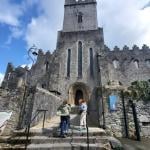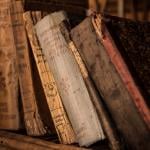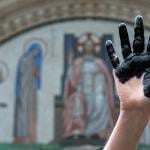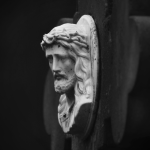OF WHAT DID THE DUUMVIRATE DELIBERATE DURING THEIR ITINERARY?: (Sorry. It’s the only line from Ulysses I can do off the top of my head besides the idiotic stuff about the horsehooves tingaling, linglingling, prrfffttt, aaaaan.) Here’s what Ratty and I did in England.
SUNDAY. Brompton Oratory. Many thanks to everyone who suggested this. We slept like two great sleeping things, so I missed the ornate Latin Mass, but the priest was deeply reverent even in the clipped and somewhat curt afternoon Mass.
MONDAY. Shopping for used books on Charing Cross Road–I bought The Glass Bead Game.
Watched “The Mousetrap.” It’s a bizarre play. Difficult to do well, I’d imagine, and the current cast (it’s the longest-running play in the world or some such) didn’t make it work. That’s not entirely their fault, since the plot involves several of Agatha Christie’s recurring themes but doesn’t really tie them together. The plot hinges on a truly terrible act–a child dies of neglect–and at the very end there’s a wheels-screeching-around-the-corner moment when suddenly the plot does a 180 from tragedy to comedy, without actually coming to terms with the tragic elements Christie’s introduced. Christie’s belief in the power of genetic inheritance is briefly on display–she refers to the belief that people follow their parents often throughout her books, although she also discards that idea whenever it gets in the way of the mystery. “The Mousetrap” also touches on her view of how England changed after World War II–the dislocations, the strangers, the way there would be people in your village whose histories you didn’t know at all. Her best book for this is probably The Mirror Crack’d From Side to Side, which is one of her best overall. (My votes: Toward Zero, The Hollow, Ten Little Indians, Death on the Nile, Murder in Retrospect, Curtain, The Mirror Crack’d…, The Labors of Hercules. Absent in the Spring, a non-mystery written under the pseudonym Mary Westmacott, is also really good–a heartbreaking story of a woman’s confrontation with her own failures and hatefulness.)
TUESDAY. The Imperial War Museum, which was phenomenal. I’ll post about that separately, possibly tomorrow.
WEDNESDAY. The Victoria and Albert Museum, that fantastic attic. I roamed the halls of locks and keys, medieval accouterments, and random artifacts, practically purring with pleasure. The Hall of Casts was terrific–plaster casts of scores of famous, imposing, or merely beautiful works of art. You got your Michelangelo David, you got your Trajan’s Column, all in one place where people who couldn’t afford to travel could come and see the world. It was much like museums’ Internet sites in that respect. There was also a German church door that reminded me of George Herbert’s poems–the left-hand side told the story of the Creation, the Fall, and the murder of Abel, descending; then, ascending the right-hand side, the Gospels, from the Annunciation to either the Resurrection or the Ascension (I forget which). Very very cool.
THURSDAY. The Tate Modern, home of the cans of artist excrement you’ve read so much about. An astonishingly ugly building. A small Giacommetti collection. A collection of grim Soviet propaganda posters–like the evil twins of the WWII British propaganda posters from the Imperial War Museum. The same themes were sounded, only instead of using charm, humor, or sentiment, the posters simply used brute force. The English had, “Careless talk costs lives!” and, “Keep mum–she’s not so dumb!”; the Soviets, “DON’T TALK.” The final poster was post-Communist (maybe Czech? Ukrainian?), and simply said, “THE END.”
The Clink, a prison museum. Not at all informative or well-designed; not really worth it at the price. (Most of the tourist-y things we did were free.) I did learn that Henry VIII legalized boiling in oil.
We tried to find a place to eat in Southwark on a Thursday afternoon. Apparently this is a mistake.
The Cabinet War Rooms–where Churchill and co. plotted to save England from Nazi invasion. Basically a shrine to Churchill, which is A-OK by me. The little audioguides were very useful and fun–you got to hear stories from secretaries detailing how demanding Churchill was (and they got to see a lot of him, since many of the secretaries would stay overnight in the underground bunker day after day), and an aide described the great man’s hilarious reaction to war news. Churchill started the morning by working in bed, and he would have the day’s news brought to him there. If he read good news, he would bounce up and down happily; if the news was bad, he would slowly sink down into the bedclothes, pulling them up toward his head a little more with each lousy piece of information, until you could only see his eyes. I bought several copies of a photograph of Churchill “inspecting a tommy gun”–he looks totally hardcore.
Then we sat in the English equivalent of Lafayette Park–the park opposite Big Ben and the Houses of Parliament. Nearby, there were statues of Lincoln and (again) Churchill, the latter wrapped in an enormous and windswept coat.
FRIDAY. We visited Highgate Cemetery and left, on Karl Marx’s grave, a picture of Hayek with the legend, “VIVA HAYEK! The Committee for Freedom, Yale University, United States of America, August 2002.”
Then to Kew Gardens. We admired cacti. There’s a carnivorous plants room there! And a piranha and two excellent, flowing stingrays.
SATURDAY. The Portobello Road market. Hectic fun, lots of music from boomboxes.
The Museum of London. Disorganized and not that exciting. But I did see an ancient Roman bikini (really). And learned this totally fascinating fact: On Holy Thursday, the King of England would wash the feet of the poor–one poor person per year of the king’s age. The last king to perform this Christian custom? William IV.
Harrods, where the Rat shopped while I had two suckaos (indescribably good–you know how H.P. Lovecraft gets all bizarre and un-specific when he tries to talk about the nameless horrors of Zoggoth or whatever? Well, for “horror” read “ecstasy,” and you’ve got me plunging my muzzle into a suckao).
SUNDAY. Brompton again, this time with its lovely and intense choir; then the airport.
Get the Rat’s take on things here (and scroll down).











